brake TOYOTA AVALON 2012 XX40 / 4.G Quick Reference Guide
[x] Cancel search | Manufacturer: TOYOTA, Model Year: 2012, Model line: AVALON, Model: TOYOTA AVALON 2012 XX40 / 4.GPages: 31, PDF Size: 1.26 MB
Page 3 of 31
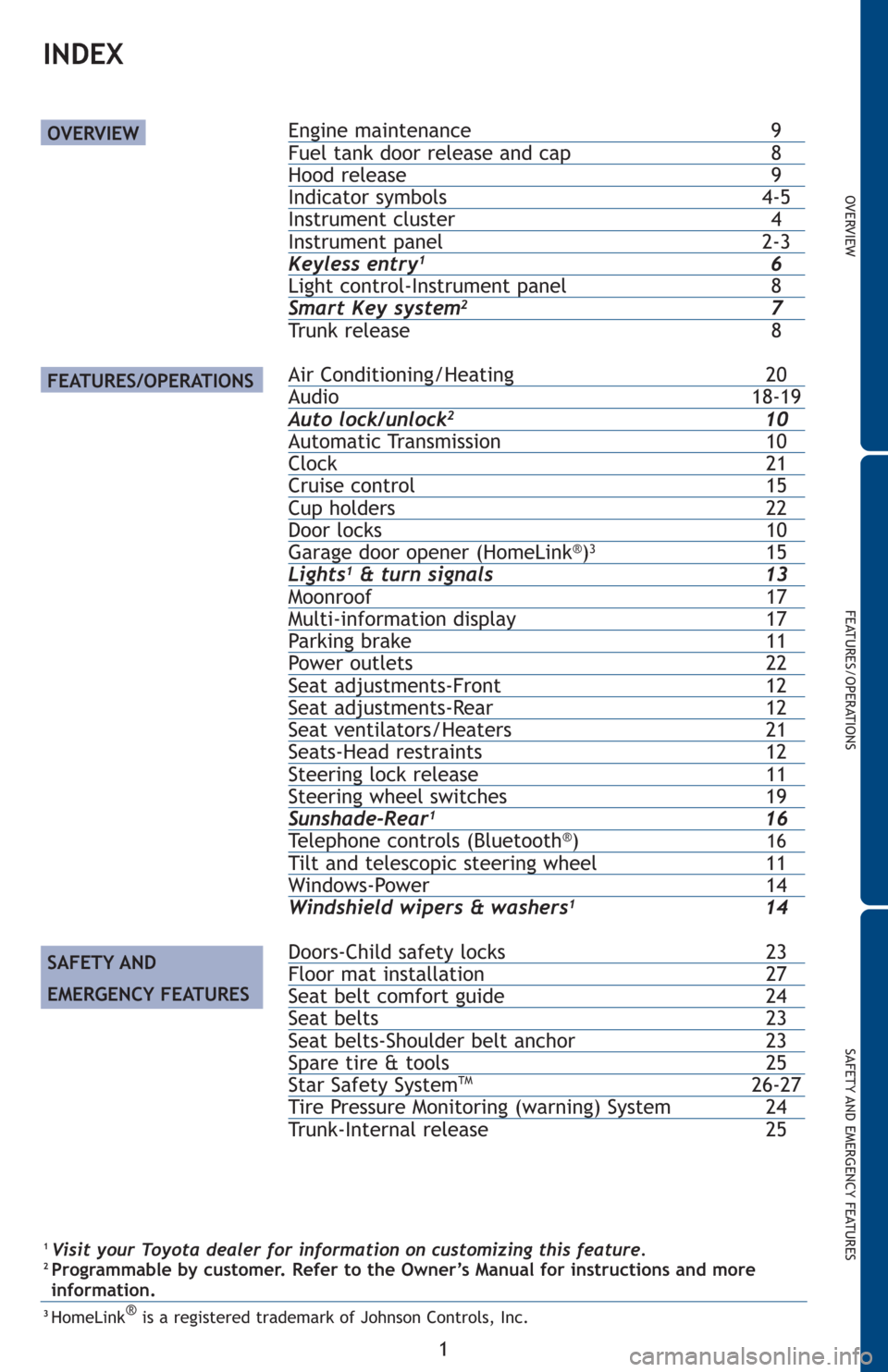
OVERVIEW
FEATURES/OPERATIONS
SAFETY AND EMERGENCY FEATURES
1
INDEX
Engine maintenance9Fuel tank door release and cap8Hood release 9Indicator symbols4-5Instrument cluster 4Instrument panel2-3Keyless entry16Light control-Instrument panel 8Smart Key system27
Trunk release 8
Air Conditioning/Heating 20Audio18-19Auto lock/unlock210Automatic Transmission 10Clock 21Cruise control15Cup holders22Door locks 10Garage door opener (HomeLink®)315Lights1& turn signals13Moonroof 17Multi-information display17Parking brake 11Power outlets 22Seat adjustments-Front12Seat adjustments-Rear12Seat ventilators/Heaters 21Seats-Head restraints 12Steering lock release 11Steering wheel switches19Sunshade-Rear116Telephone controls (Bluetooth®)16Tilt and telescopic steering wheel11Windows-Power 14
Windshield wipers & washers114
Doors-Child safety locks 23Floor mat installation27Seat belt comfort guide24Seat belts 23Seat belts-Shoulder belt anchor23Spare tire & tools 25Star Safety SystemTM26-27Tire Pressure Monitoring (warning) System 24
Trunk-Internal release 25
OVERVIEW
FEATURES/OPERATIONS
SAFETY AND
EMERGENCY FEATURES
1 Visit your Toyota dealer for information on customizing this feature.2 Programmable by customer. Refer to the Owner’s Manual for instructions and more
information.
3HomeLink®is a registered trademark of Johnson Controls, Inc.
Page 6 of 31
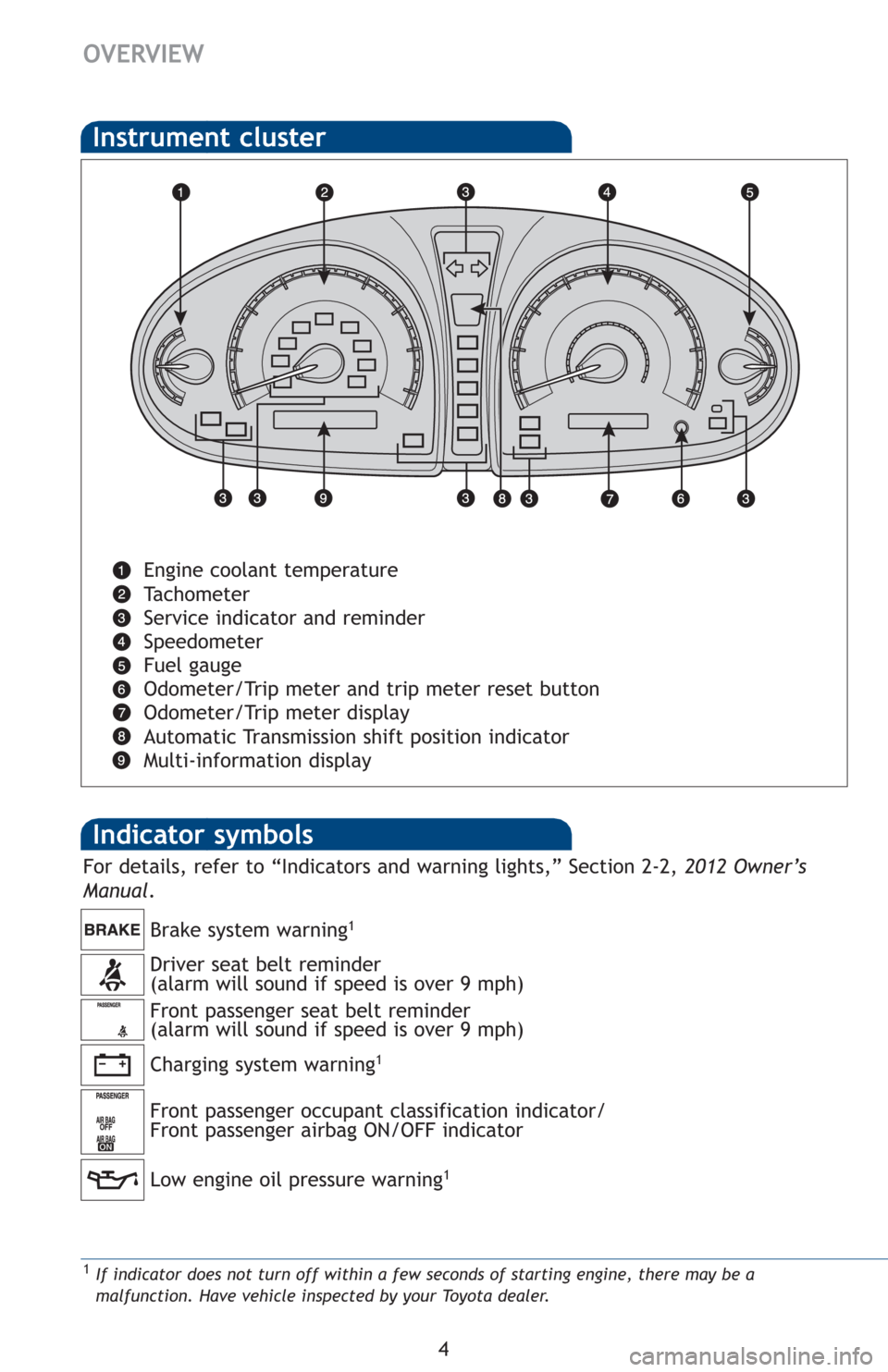
4
OVERVIEW
Indicator symbols
Instrument cluster
Engine coolant temperature
Tachometer
Service indicator and reminder
Speedometer
Fuel gauge
Odometer/Trip meter and trip meter reset button
Odometer/Trip meter display
Automatic Transmission shift position indicator
Multi-information display
Charging system warning1
Brake system warning1
1If indicator does not turn off within a few seconds of starting engine, \
there may be a
malfunction. Have vehicle inspected by your Toyota dealer.
Driver seat belt reminder
(alarm will sound if speed is over 9 mph)
Front passenger seat belt reminder
(alarm will sound if speed is over 9 mph)
Low engine oil pressure warning1
Front passenger occupant classification indicator/
Front passenger airbag ON/OFF indicator
For details, refer to “Indicators and warning lights,” Section 2-2\
,
2012 Owner’s
Manual .
Page 7 of 31
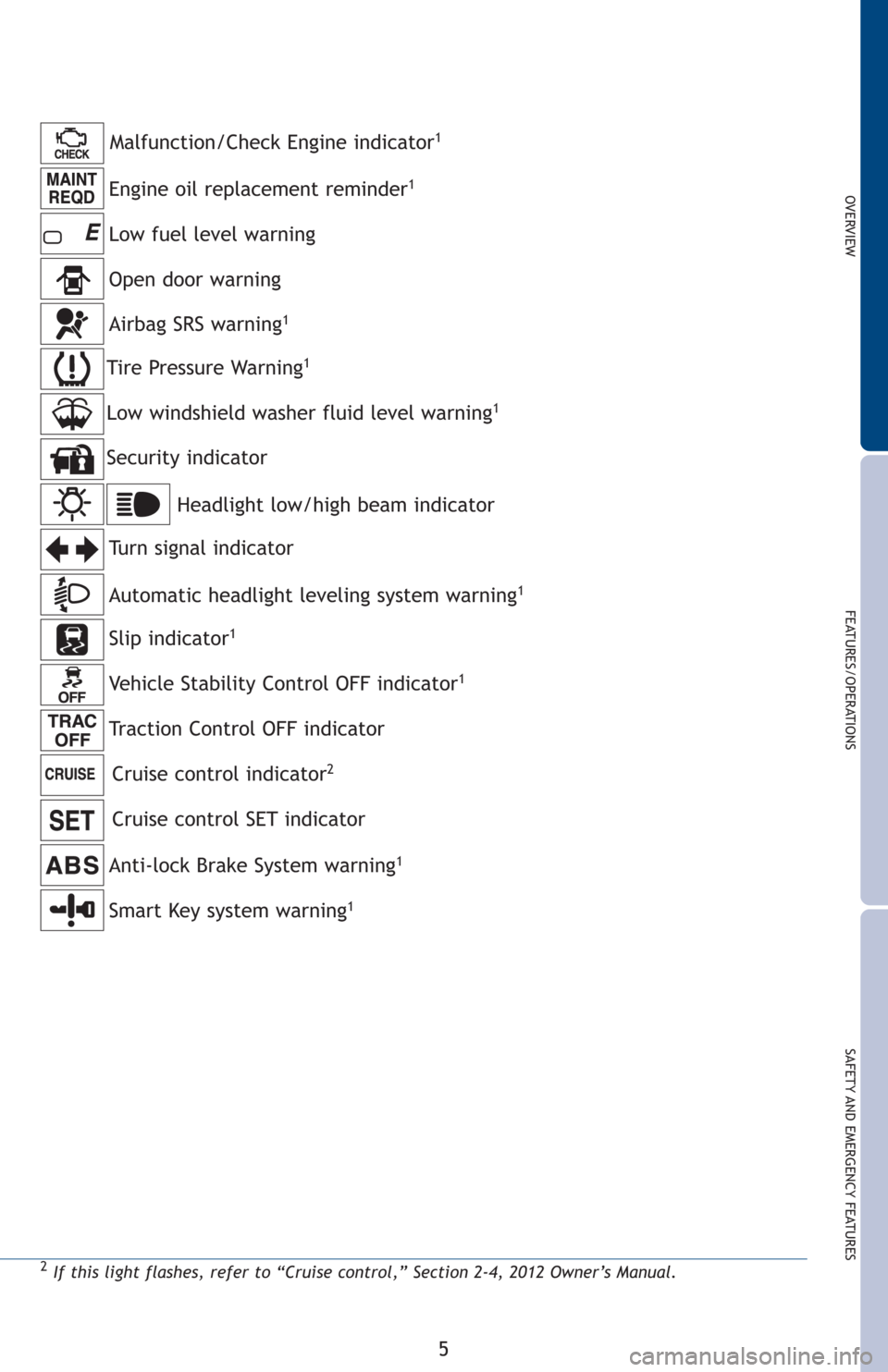
OVERVIEW
FEATURES/OPERATIONS
SAFETY AND EMERGENCY FEATURES
5
Anti-lock Brake System warning1
Headlight low/high beam indicator
Turn signal indicator
Slip indicator
1
Vehicle Stability Control OFF indicator1
Cruise control indicator2
Tire Pressure Warning1
Security indicator
Open door warning
Airbag SRS warning1
Low windshield washer fluid level warning1
Malfunction/Check Engine indicator1
Engine oil replacement reminder1
Low fuel level warning
Automatic headlight leveling system warning1
Smart Key system warning1
2If this light flashes, refer to “Cruise control,” Section 2-4, 201\
2 Owner’s Manual.
Traction Control OFF indicator
Cruise control SET indicator
Page 9 of 31
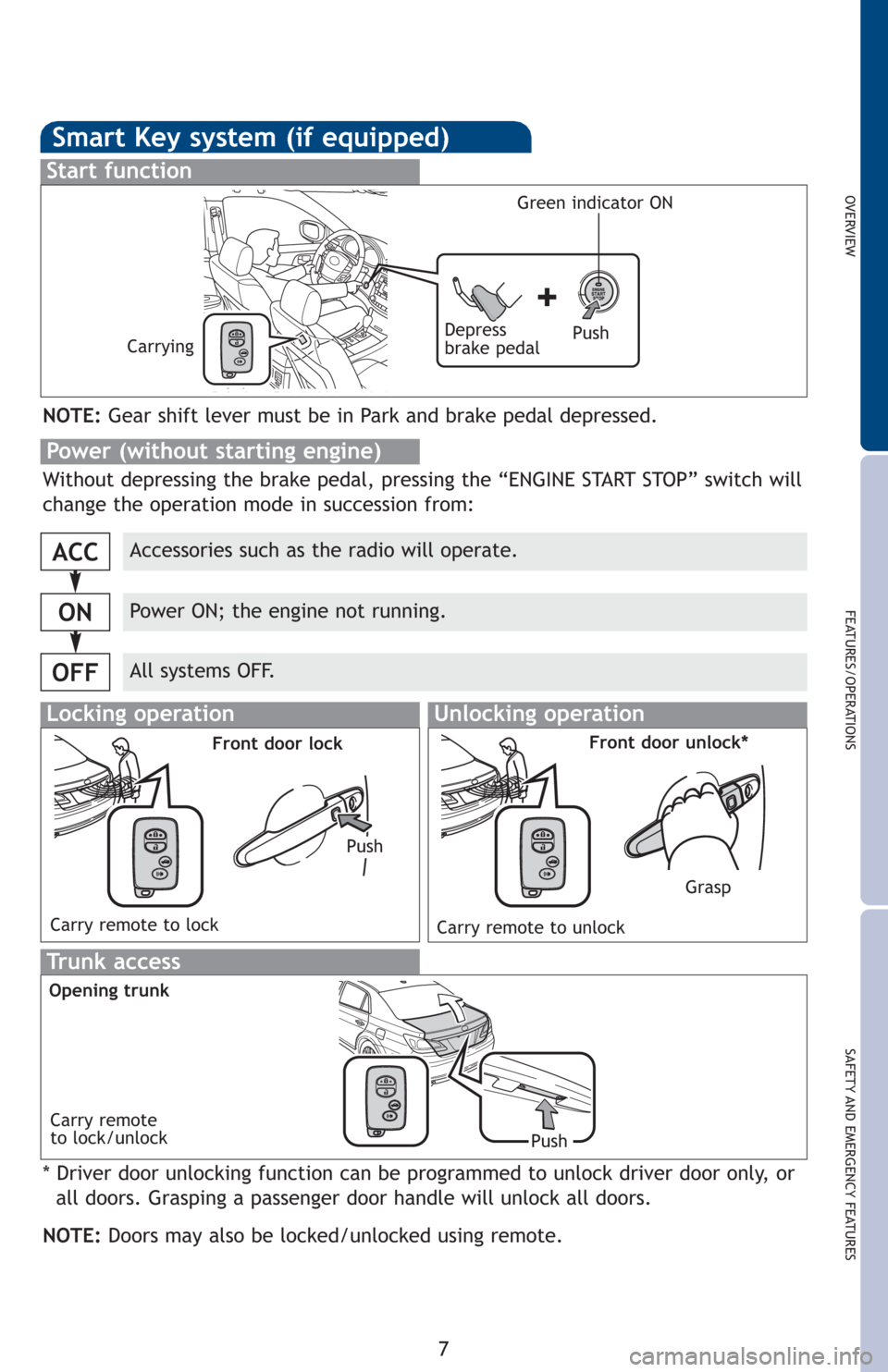
OVERVIEW
FEATURES/OPERATIONS
SAFETY AND EMERGENCY FEATURES
7
Smart Key system (if equipped)
Start function
NOTE:Gear shift lever must be in Park and brake pedal depressed.
Push
Depress
brake pedal
Carrying
Green indicator ON
Without depressing the brake pedal, pressing the “ENGINE START STOP” switch will
change the operation mode in succession from:
Power (without starting engine)
* Driver door unlocking function can be programmed to unlock driver door\
only, or
all doors. Grasping a passenger door handle will unlock all doors.
NOTE: Doors may also be locked/unlocked using remote.
Accessories such as the radio will operate.
Power ON; the engine not running.
All systems OFF.
ACC
ON
OFF
Trunk access
Opening trunk
Locking operationUnlocking operation
Carry remote to lock
Carry remote to unlock
Front door lockFront door unlock*
Push
Grasp
Push
Carry remote
to lock/unlock
Page 12 of 31
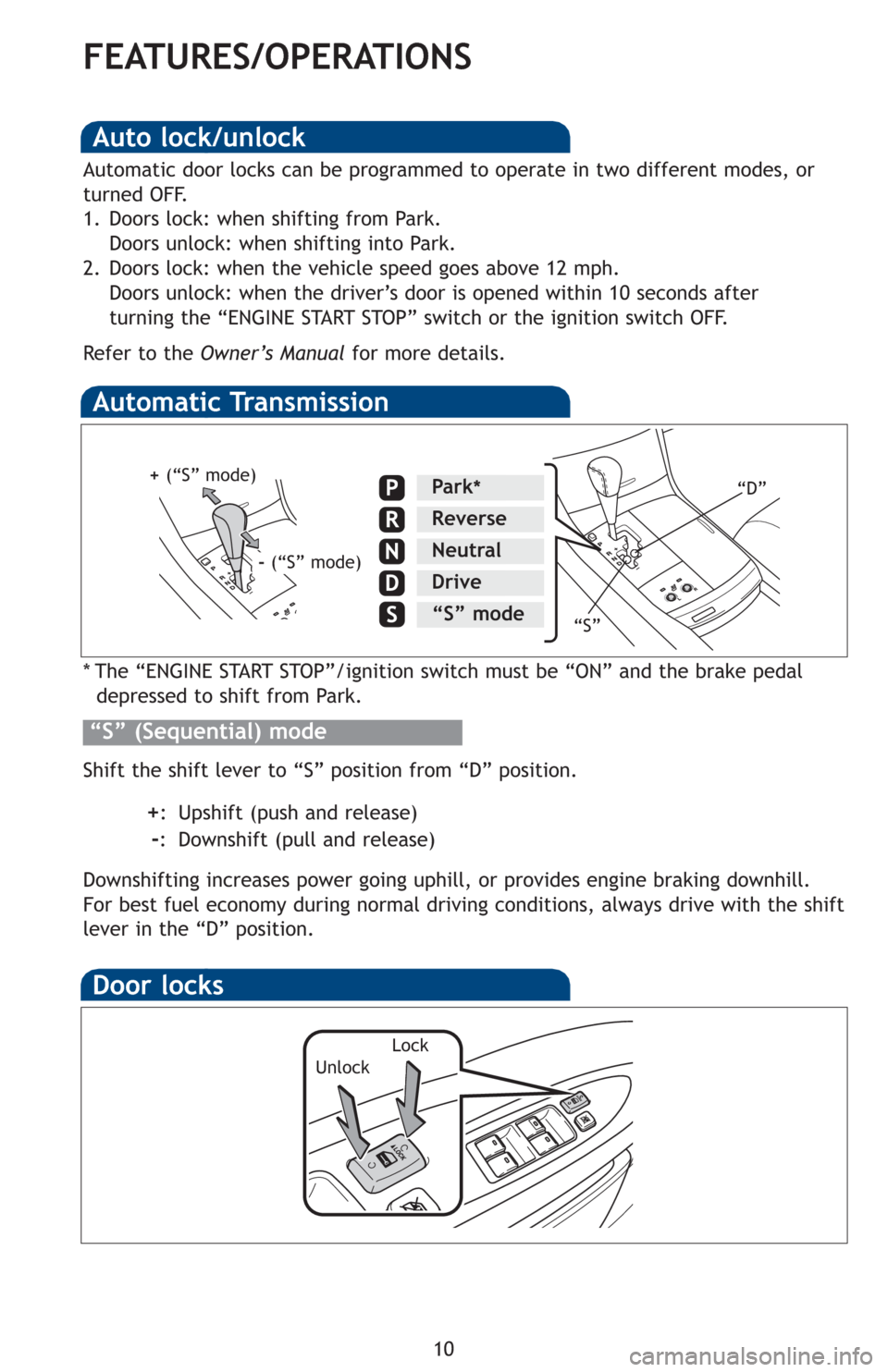
10
FEATURES/OPERATIONS
Automatic Transmission
* The “ENGINE START STOP”/ignition switch must be “ON” and the brake pedal depressed to shift from Park.
Shift the shift lever to “S” position from “D” position.
+: Upshift (push and release)
-: Downshift (pull and release)
Downshifting increases power going uphill, or provides engine braking do\
wnhill.
For best fuel economy during normal driving conditions, always drive wit\
h the shift
lever in the “D” position.
“S” (Sequential) mode
Park*
Reverse
Neutral
Drive
“S” mode“S” “D”
Auto lock/unlock
Automatic door locks can be programmed to operate in two different modes\
, or
turned OFF.
1. Doors lock: when shifting from Park.
Doors unlock: when shifting into Park.
2. Doors lock: when the vehicle speed goes above 12 mph. Doors unlock: when the driver’s door is opened within 10 seconds after
turning the “ENGINE START STOP” switch or the ignition switch OFF.
Refer to the Owner’s Manual for more details.
Door locks
LockUnlock
+(“S” mode)
-(“S” mode)
Page 13 of 31
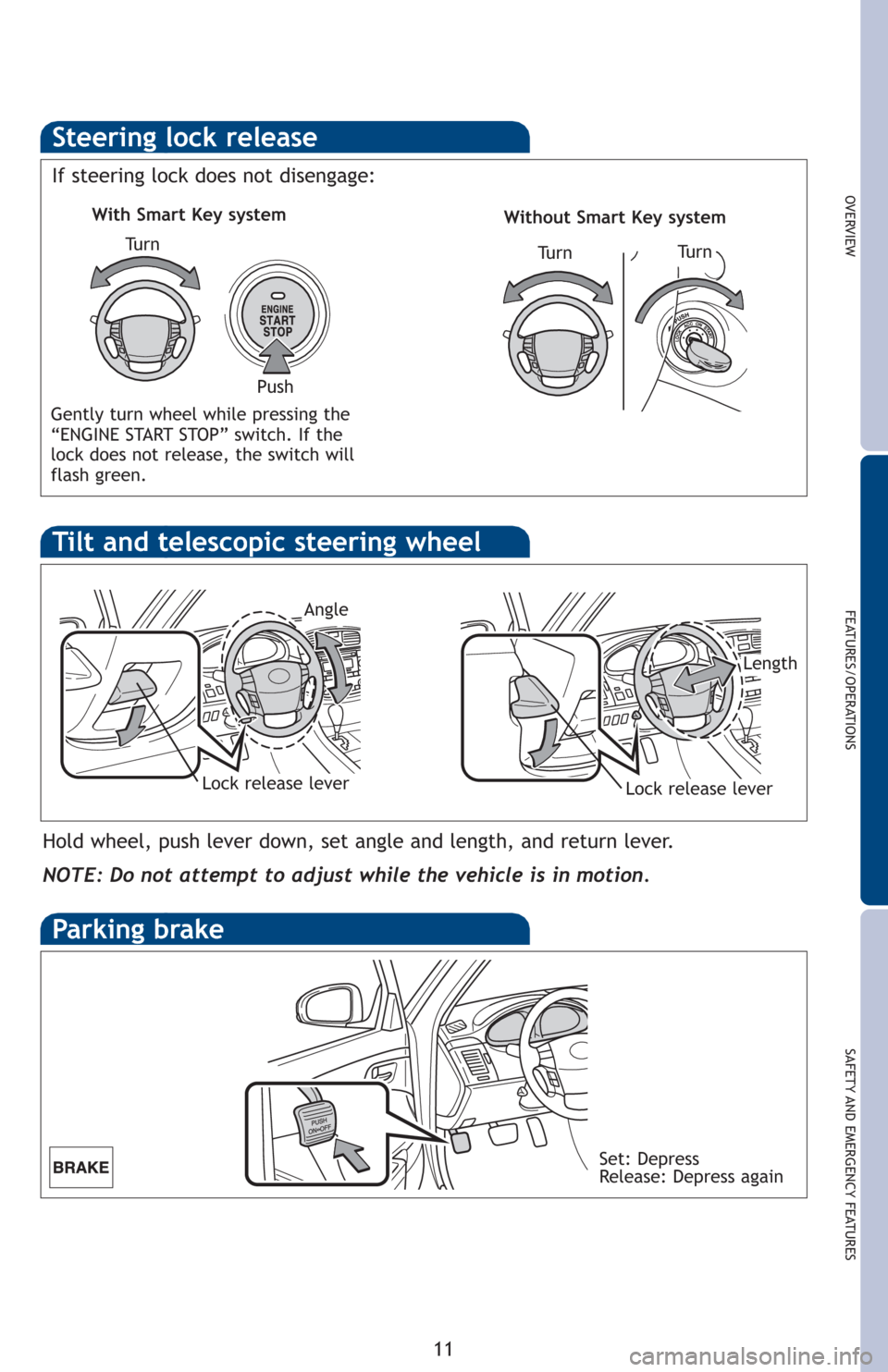
OVERVIEW
FEATURES/OPERATIONS
SAFETY AND EMERGENCY FEATURES
11
Steering lock release
Tu r n
Tu r n
With Smart Key system
Without Smart Key system
Push
Tu r n
Parking brake
Set: Depress
Release: Depress again
Hold wheel, push lever down, set angle and length, and return lever.
NOTE: Do not attempt to adjust while the vehicle is in motion.
Tilt and telescopic steering wheel
Angle
Length
Lock release leverLock release lever
Gently turn wheel while pressing the
“ENGINE START STOP” switch. If the
lock does not release, the switch will
flash green.
If steering lock does not disengage:
Page 17 of 31
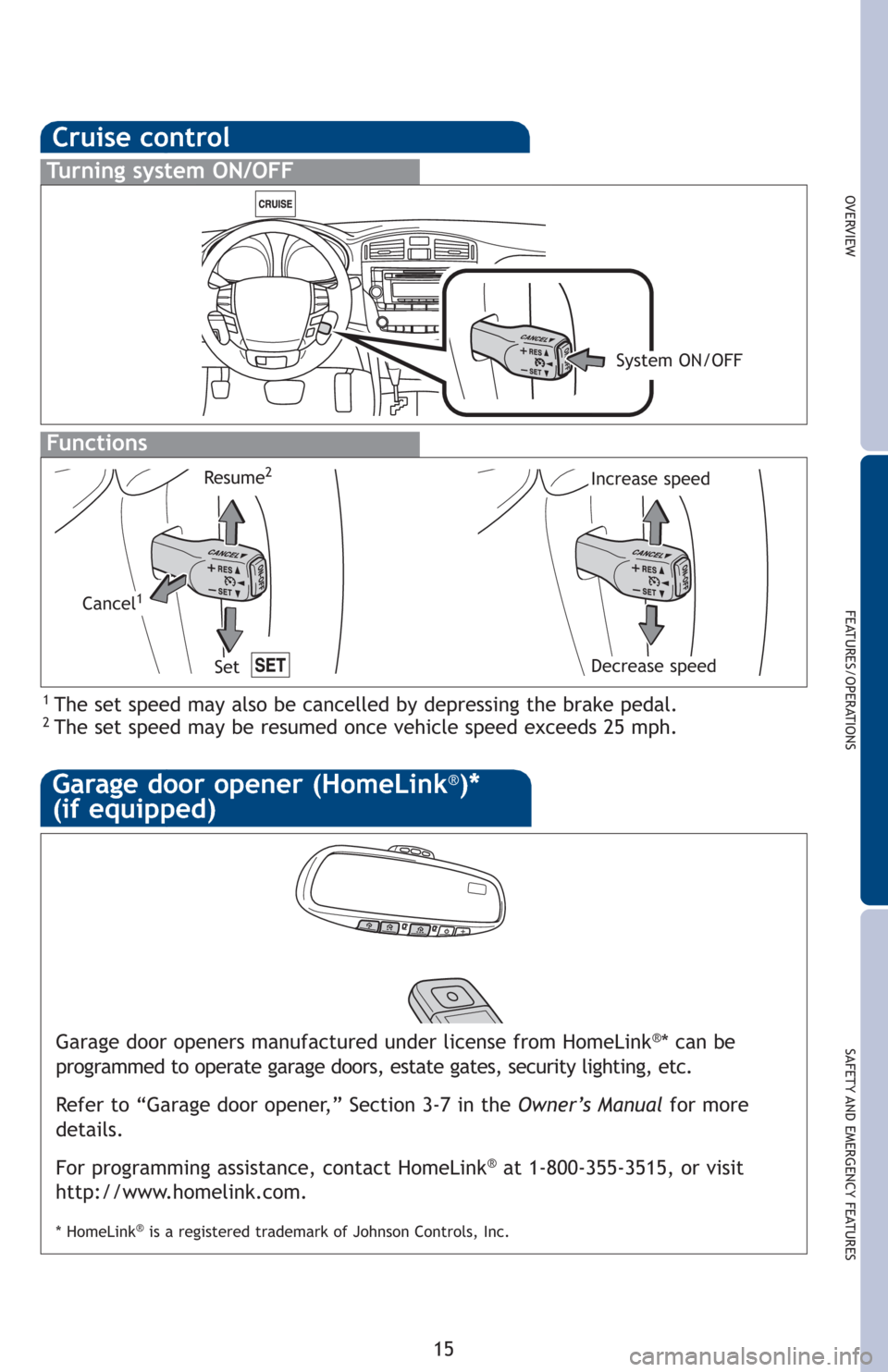
OVERVIEW
FEATURES/OPERATIONS
SAFETY AND EMERGENCY FEATURES
15
Cruise control
1 The set speed may also be cancelled by depressing the brake pedal.2 The set speed may be resumed once vehicle speed exceeds 25 mph.
Turning system ON/OFF
Functions
System ON/OFF
Increase speed
Decrease speed
Cancel1
Resume2
Set
Garage door opener (HomeLink®)*
(if equipped)
Garage door openers manufactured under license from HomeLink®* can be
programmed to operate garage doors, estate gates, security lighting, etc\
.
Refer to “Garage door opener,” Section 3-7 in the Owner’s Manualfor more
details.
For programming assistance, contact HomeLink
®at 1-800-355-3515, or visit
http://www.homelink.com.
* HomeLink®is a registered trademark of Johnson Controls, Inc.
Page 28 of 31
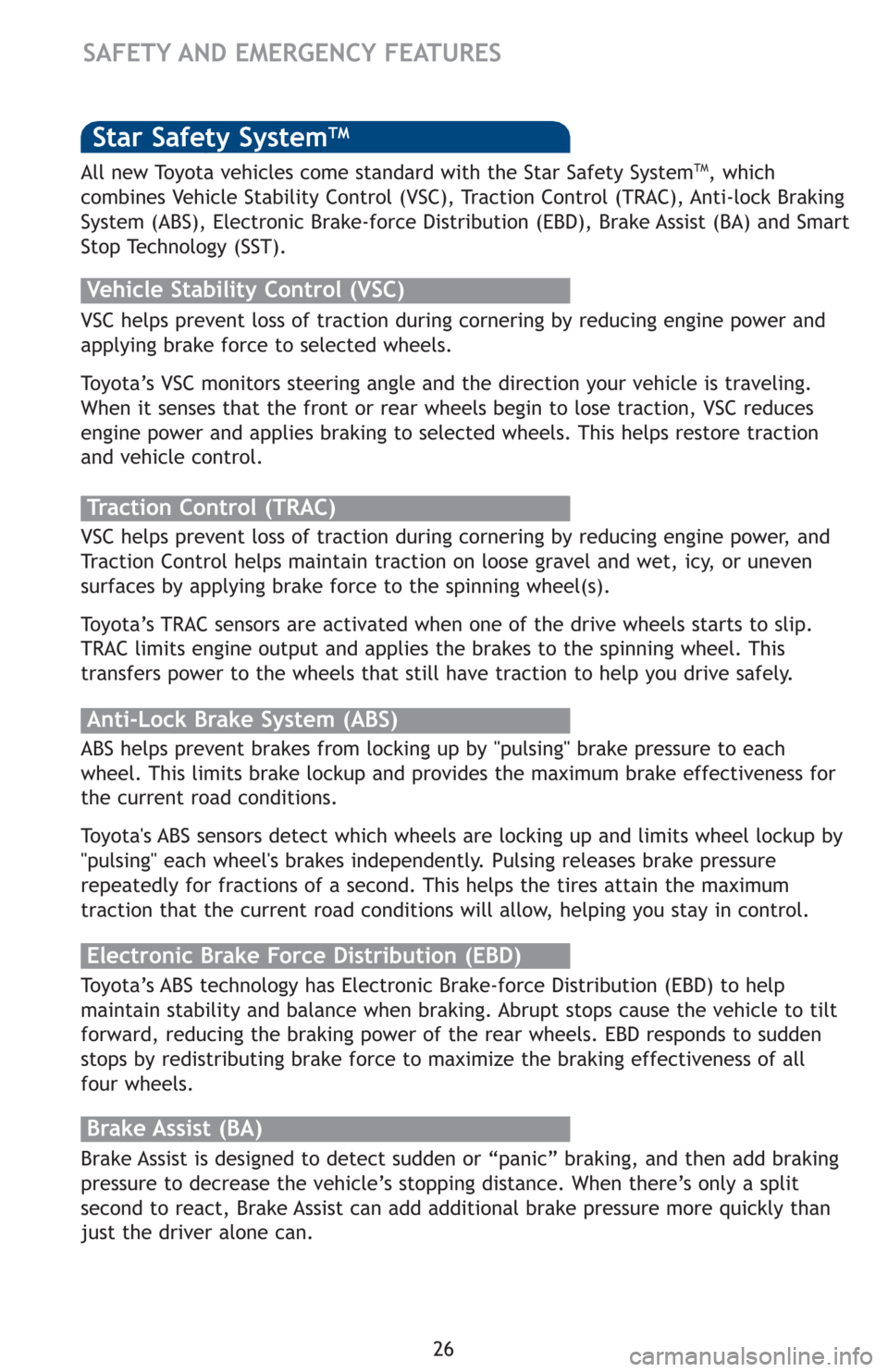
26
Star Safety SystemTM
VSC helps prevent loss of traction during cornering by reducing engine p\
ower and
applying brake force to selected wheels.
Toyota’s VSC monitors steering angle and the direction your vehicle is travelin\
g.
When it senses that the front or rear wheels begin to lose traction, VSC\
reduces
engine power and applies braking to selected wheels. This helps restore traction
and vehicle control.
Vehicle Stability Control (VSC)
Anti-Lock Brake System (ABS)
Brake Assist (BA)
ABS helps prevent brakes from locking up by "pulsing" brake pressure to \
each
wheel. This limits brake lockup and provides the maximum brake effectiveness fo\
r
the current road conditions.
Toyota's ABS sensors detect which wheels are locking up and limits wheel lockup b\
y
"pulsing" each wheel's brakes independently. Pulsing releases brake pressure
repeatedly for fractions of a second. This helps the tires attain the maximum
traction that the current road conditions will allow, helping you stay in control.
Brake Assist is designed to detect sudden or “panic” braking, and then a\
dd braking
pressure to decrease the vehicle’s stopping distance. When there’s only a split
second to react, Brake Assist can add additional brake pressure more quickly than
just the driver alone can. VSC helps prevent loss of traction during cornering by reducing engine p\
ower, and
Traction Control helps maintain traction on loose gravel and wet, icy, or uneven
surfaces by applying brake force to the spinning wheel(s).
Toyota’s TRAC sensors are activated when one of the drive wheels starts to slip.
TRAC limits engine output and applies the brakes to the spinning wheel. \
This
transfers power to the wheels that still have traction to help you drive\
safely.
Traction Control (TRAC)
Electronic Brake Force Distribution (EBD)
Toyota’s ABS technology has Electronic Brake-force Distribution (EBD) to help
maintain stability and balance when braking. Abrupt stops cause the vehicle to tilt
forward, reducing the braking power of the rear wheels. EBD responds to \
sudden
stops by redistributing brake force to maximize the braking effectivenes\
s of all
four wheels.
SAFETY AND EMERGENCY FEATURES
All new Toyota vehicles come standard with the Star Safety SystemTM, which
combines Vehicle Stability Control (VSC), Traction Control (TRAC), Anti-lock Braking
System (ABS), Electronic Brake-force Distribution (EBD), Brake Assist (BA) and Smart
Stop Technology (SST).
Page 29 of 31
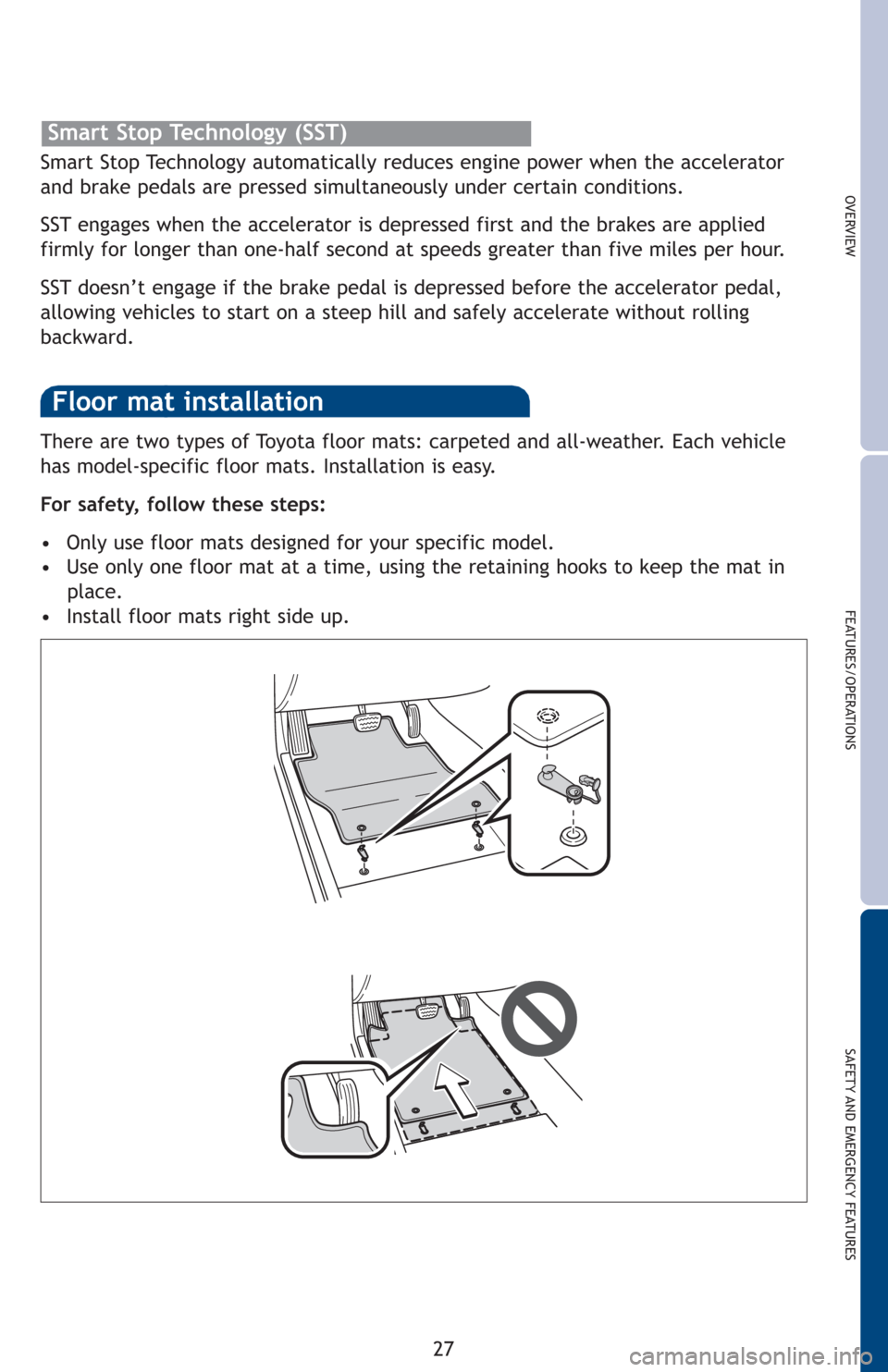
OVERVIEW
FEATURES/OPERATIONS
SAFETY AND EMERGENCY FEATURES
27
There are two types of Toyota floor mats: carpeted and all-weather. Each vehicle
has model-specific floor mats. Installation is easy.
For safety, follow these steps:
• Only use floor mats designed for your specific model.
• Use only one floor mat at a time, using the retaining hooks to keep the \
mat in
place.
• Install floor mats right side up.
Floor mat installation
Smart Stop Technology automatically reduces engine power when the accelerator
and brake pedals are pressed simultaneously under certain conditions.
SST engages when the accelerator is depressed first and the brakes are appl\
ied
firmly for longer than one-half second at speeds greater than five miles\
per hour.
SST doesn’t engage if the brake pedal is depressed before the accelerato\
r pedal,
allowing vehicles to start on a steep hill and safely accelerate without\
rolling
backward.
Smart Stop Technology (SST)